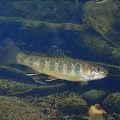“Brown Trout After Dark”
Leave it to the French to coin a nifty phrase for dusk: entre chien et loup, “between the dog and the wolf,” the transition zone between day and night, between furry family pet Fido and dagger-toothed predator. It’s my handsdown absolute favorite time to be on the river. A sense of mystery hangs over the whole scene. As the sun lowers toward the horizon both water and air cool, the wind often dies down to make casting easier, the day’s commotion and bullshit quotient lessens, the mind’s white noise subsides, and as evening moves inexorably toward dark, inward sensations heighten when the palette of colors the eye is heir to deepens, darkens, becomes less expansive and familiar. Technicolor fades to chiaroscuro. If Baudelaire had been a fly fisherman he might have discovered his belief in the “derangement of the senses” after angling at night.
Start fishing in the morning and the whole day, with its clear, dazzling sunlit shapes, opens out before you like a welcome greeting. Step in the Madison in the evening and the opposite is true. Perception changes. It’s like looking down the wrong end of a telescope, or like crossing a border into some foreign territory, some twilight-edged zone, where spookiness and a warped sense of time reign.
Some of the fastest, most furious, and most memorable action comes in the transitional period as dusk morphs into dark when my favorite bugs, the under-valued Hydropsyche caddis—spotted sedge, cinnamon caddis, call it whatever—and the Lepidostoma caddis—little brown sedge—ramp up their wild emergence and bring acrobatic trout up to the surface in sizable numbers. To be in the midst of a full-blown emergence of these supremely important insects is magical. The later it gets, the heavier the hatch, the more aggressive the trout become. Once hatched, caddis don’t ride the currents like mayflies, but pop out and are quickly gone, headed for their sex-starved rendezvous. Trout of the Madison have to be contortionists themselves, willing at times to go airborne like missiles to capture a meal. Dimples, rings, swirls, splashes, and watery commotion mark their efforts. As light fades, caddis land on my hands, crawl on my face, my glasses, my vest, my arms. I pop one in my mouth to see what all the hubbub is about. As bugs go, this one doesn’t taste like much more than dust. But the trout love them and that’s what counts.
Brown trout, with their fixed-iris eyes, are best suited to low-light, night-hunting conditions. They are “negatively phototropic,” Cecil Heacox says in his elegant study, The Compleat Brown Trout. But what’s preferred by them is alien to me. After 9 p.m. and for the next couple of hours, I’m a stranger in a strange world, urged on by some inchoate stirring in me that has no name. That and the chance at a goodly fish.
Orientation, my sense of how and where I am positioned in a darkening riverine world, grows more tenuous minute by minute. There is a Zenlike quality to post-twilight fishing, because, almost blind, I have to grope my way forward, let go of linearity, trust in faith and my latent senses, rely on the unseen. The approach is indirect compared to daytime’s routine. Nothing can be taken for granted. Wading is difficult and must be done slowly; it feels more like prowling than walking. For a brief span of time I too become a night predator. I’m an owl or a mink, though I don’t see as well. A small Petzl headlamp and a compact gooseneck light in my vest help illumine close, minute work, but even they are limited in wide-range usefulness. I keep them shut off most of the time, but at the ready. Having fished a place numerous times in daylight helps get the lay of the river bottom fixed in my internal compass. But no matter what, this is fishing with my inner eye.
Hook a fish after dark in one of the slick areas near the bank, and most of the time it will head directly for heavy mid-river current to escape. With luck and steady pressure it can be turned quickly, but more than likely requires a sprint that ends up twenty-five to fifty yards or more downstream from where I started. In darkness, that gives new meaning to hanging on for dear life. Precariousness keeps me alert and guarded.
There is an odd, even eerie, sensuousness to hooking then fighting a fish you can’t really see, but can only feel through its pumping, surging motion. The imagination runs wild in the inky darkness. The effect is jolting, electric, like you’ve just touched a live wire, or peeped into a forbidden room. Trying to net a fish in the dark, even with a headlamp shining at that crucial moment, is a hit-and-miss affair as though the nighttime world is tilted off-center, pitched at an unaccustomed angle. It isn’t always possible to see the whole arc of action, from hand and arm to rod and to line and leader and hooked trout. The trout’s only a rod length away just under the surface. It is frothing the water with desperate lunges and hell-bent surges, but is difficult to see in its entirety, so it’s best to look for the glint of the leader and follow it downward. Stabbing with the net at the spectral form is like trying to corral a ghost or an idea. Margins for angler error increase exponentially. Here now, there now.
![]() Around 8 p.m. last night below Raynolds Pass Bridge I found numerous fish working in one of my most treasured slicks, a wide indent behind several boulders where the heavy current is shunted away and leaves a relatively placid and smooth window of water. I got outside and downstream of them and cast a short manageable line slightly over and across the riseforms using a modified dead drift with a modest upstream mend. When these trout are on their game, as they were last night, not much will put them down. It’s possible to get fairly close without spooking them. Better that than a long flailing cast across several kinds of current and flies tumbling and dragging willy-nilly. Started with #17 olive Iris Caddis as dry top fly and an antron Caddis Pupa as a wet dropper. Second cast a goodly fish took the dropper and broke me off. Lesson learned: I re-rigged, this time with 4X tippet instead of 5X.
Around 8 p.m. last night below Raynolds Pass Bridge I found numerous fish working in one of my most treasured slicks, a wide indent behind several boulders where the heavy current is shunted away and leaves a relatively placid and smooth window of water. I got outside and downstream of them and cast a short manageable line slightly over and across the riseforms using a modified dead drift with a modest upstream mend. When these trout are on their game, as they were last night, not much will put them down. It’s possible to get fairly close without spooking them. Better that than a long flailing cast across several kinds of current and flies tumbling and dragging willy-nilly. Started with #17 olive Iris Caddis as dry top fly and an antron Caddis Pupa as a wet dropper. Second cast a goodly fish took the dropper and broke me off. Lesson learned: I re-rigged, this time with 4X tippet instead of 5X.
As it got darker, more fish cruised to the feeding grounds, and I counted at least a dozen working and rolling regularly on the surface. Changed again, this time to a tan #17 Iris Caddis on top and a #18 tan X-Caddis as dropper, both dressed and fished dry. Took a healthy-looking 14-inch rainbow on the X, a welcome surprise, then a 17-inch brown, an even nicer surprise, then lost a third fish, way bigger, when it threw the barbless hook. That’s the thing about fighting fish in those conditions—you can’t see them but you learn to feel their size, sent up in a series of seismic shocks and head shakes through the rod and into your hand and arm.
The dark also compounds terminal tackle fuck-ups. Don’t know why, but the lost fish caused a ridiculous tangle. Even with my two small lights blazing away, re-rigging was slow for these old eyes. Then disaster struck: when I had my two flies retied and redressed I clipped what I thought was a tag end but it turned out to be the main tippet. Curses and lamentations. Back to square one to get it all straightened out and redeem my ineptitude.
Trout were still active at 9:30 p.m., and under a clear half-moon there was enough residue of light to make out some enticing wakes and phosphorescent splashes, but not enough light to see my flies or the take. Even the white zelon wing loop on the Iris Caddis disappears in these conditions. I have to imagine the fly on the water. This is Hail Mary fishing. Make an offering, say a prayer, hope for the best. Discretion says reel up and head home, you’ve had enough; adrenaline says stay where you are, fool, and keep fishing.
I cast the same short amount of line each time so I have at least a vague sense of where my fly is in relation to the risers. I squint into the gloaming and strain my eyes to look for any aberrant movement in the water or some little out-of-the-ordinary twinkle or refraction that signals a feeding trout. I know fish are down there, and the later it gets, the bigger, more wolflike the trout that swim into range in the placid side pockets.
At a certain point it is impossible to distinguish between movement on the surface made by a feeding fish and that caused by river hydraulics. By then I have no choice but to go to my wing-and-prayer method: short cast of twenty feet or so, track line as best I can, then as the flies drift downstream, count a silent 1001, 1002, 1003, 1004, then lift the rod tip. It’s an exercise in uncanniness, extrasensoriness. It’s a crap shoot, too, because the take can’t be seen, though by my reckoning six out of ten times there’s a fish on when I lift. Often, the later it is the bigger the trout is. Face it: my life would be a lot simpler, my fishing a lot more streamlined, if I threw big meat-hook streamers or mouse patterns after dark to draw explosive strikes that telegraph a trout’s location, but somehow, given my small-fly fascination, that would be cribbing.
Last night it was a brilliant hen brown, solidly hooked, on the little X-Caddis. As soon as she hit I knew I was onto a special fish. I had to scramble downstream before I could steer her close, and even at that I missed her twice with my net. She taped out around 22 inches and I guessed her weight at four pounds, and her age at five years or more. She was a bit smaller than the bruiser I got last year under similar conditions, and a bit bigger than some 20-inch beauts—two browns and one rainbow—I got last week. She was so girthy I could hardly get my wet hands around her when I slipped her back into the river. Holding her rear section, her tail wrist, in my left hand and cradling her forward body in my right, I gently swam her back and forth in the current. Then her entire body shuddered, like a single flexed muscle, and she rocketed away. It’s another kind of magical moment, strange and eerie and humbling, too, to be in command of such an elusive wild creature, such a dream fish, even for a few seconds while it regains its mojo. It’s only an illusion that I’m in charge. Who says it ain’t love ’em, then leave ’em?
![]() I reeled up and walked out. The moon drifted in and out of the clouds. Everpresent amber mercury lamp in the front yard of a vacation cabin near the bridge led me out along the bluff path toward the road. It was nearly 11 p.m. when I crossed the cattle guard near the highway. Except for a few swooping nighthawks, the parking area was empty. My truck thermometer read fifty-four degrees, almost twenty degrees cooler than when I started. Until I reached the truck I hadn’t noticed the change. I shed my vest and waders, stowed gear, and put on an extra shirt. I could hear the great river rushing on in the darkness, implacable, as it had rushed on for millennia.
I reeled up and walked out. The moon drifted in and out of the clouds. Everpresent amber mercury lamp in the front yard of a vacation cabin near the bridge led me out along the bluff path toward the road. It was nearly 11 p.m. when I crossed the cattle guard near the highway. Except for a few swooping nighthawks, the parking area was empty. My truck thermometer read fifty-four degrees, almost twenty degrees cooler than when I started. Until I reached the truck I hadn’t noticed the change. I shed my vest and waders, stowed gear, and put on an extra shirt. I could hear the great river rushing on in the darkness, implacable, as it had rushed on for millennia.
I was home, then, for now.












